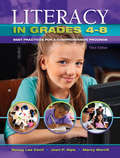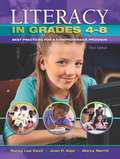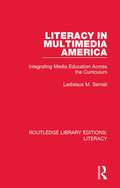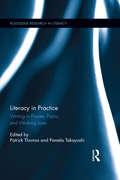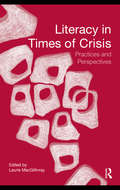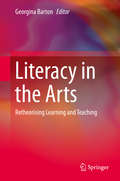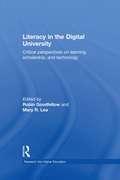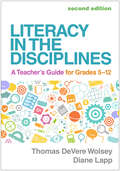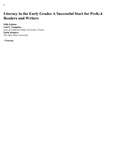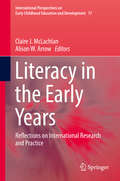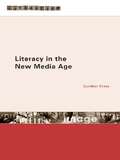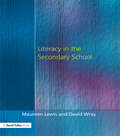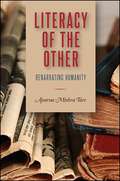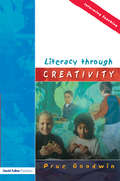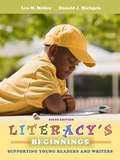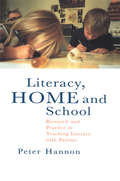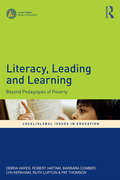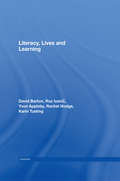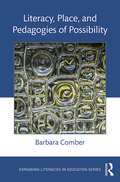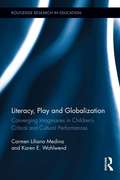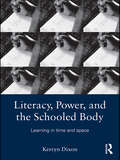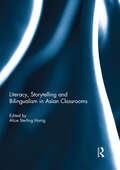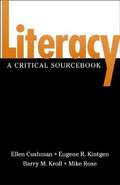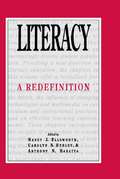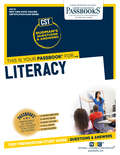- Table View
- List View
Literacy in Grades 4-8: Best Practices for a Comprehensive Program
by Joan P. Gipe Merrill E. Marcy Nancy L. CecilComprehensive yet succinct and readable, Literacy in Grades 4-8, Third Edition offers a wealth of practical ideas to help preservice and practicing teachers create a balanced and comprehensive literacy program while exploring the core topics and issues of literacy in grades 4 through 8. It addresses teaching to standards; differentiating instruction for readers and writers; motivating students; using assessment to inform instruction; integrating technology into the classroom; working with English learners and struggling readers; and connecting with caregivers. Selected classroom strategies, procedures, and activities represent the most effective practices according to research and the many outstanding classroom teachers who were observed and interviewed for the book. The Third Edition includes added material connecting the Common Core State Standards to the instruction and assessment of literacy skills; a combined word study and vocabulary chapter to help readers integrate these important topics in their teaching; more on technology, including comprehension of multimodal texts, enhancing writing instruction with technology tools, and teaching activities with an added technology component; added discussion of teacher techniques during text discussions, strategic moves that help students become more strategic readers.Key features: In the Classroom vignettes; more than 50 activities,some with a technology component; questions for journal writing and for projects and field-based activities; troubleshooting sections offering alternative suggestions and activities for those middle-grade students who may find a particular literacy focus challenging.
Literacy in Grades 4-8: Best Practices for a Comprehensive Program,Third Edition
by Nancy Lee Cecil Joan P. Gipe Marcy MerrillComprehensive yet succinct and readable, this book offers a wealth of practical ideas to help preservice and practicing teachers create a balanced and comprehensive literacy program while exploring the core topics and issues of literacy in grades 4 through 8. It addresses teaching to standards, including the Common Core State Standards; differentiating instruction for readers and writers; motivating students; using assessment to inform instruction; integrating technology into the classroom; working with English learners and struggling readers; and connecting with caregivers. Selected classroom strategies, procedures, and activities represent the most effective practices according to research and the many outstanding classroom teachers who were observed and interviewed for the book. Literacy in Grades 4 8 will give teachers the practical skills they need to motivate today s diverse learners.
Literacy in Multimedia America: Integrating Media Education Across the Curriculum (Routledge Library Editions: Literacy #20)
by Ladislaus M SemaliOriginally published in 2000. This book provides insights, practical suggestions and clear-cut strategies for integrating media across the K-12 curriculum. This contribution to teaching and curriculum design uses students' own media experiences or media vignettes from students' lives to enter teaching and learning. It provides a road map for teachers longing to reflect and take seriously the knowledge students bring to school from their homes and communities, and to draw upon this background to develop students' critical thinking, viewing and reading of written texts, visuals, and other electronic images and messages.
Literacy in Practice: Writing in Private, Public, and Working Lives (Routledge Research in Literacy #7)
by Patrick Thomas Pamela TakayoshiThe rise of New Literacy Studies and the shift from studying reading and writing as a technical process to examining situated literacies--what people do with literacy in particular social situations--has focused attention toward understanding the connections between reading and writing practices and the broader social goals and cultural practices these literacy practices help to shape. This collection brings together situated research studies of literacy across a range of specific contexts, covering everyday, educational, and workplace domains. Its contribution is to provide, through an empirical framework, a larger cumulative understanding of literacy across diverse contexts.
Literacy in Times of Crisis: Practices and Perspectives
by Laurie MacGillivray"Fresh, provocative, timely, and important, this volume extends the field of sociocultural literacies in new directions."--Marjorie Faulstich Orellana, University of California, Los Angeles On the frontline of critical issues in education today, this book covers new ground for teachers and teacher educators for whom crisis is a daily part of their work. It explores the relationship between crisis and literacy in order to: improve educators’ ability to recognize, cope with, and avoid crisis; advance understanding of the dynamic relationship between crisis and cultural, historical, and political literacy practices; and contribute to a deeper theoretical understanding of literacy practices as they are situated in social practices. The types of crises addressed are diverse, including natural disaster, cultural and community disjuncture, homelessness, family upheaval, teen pregnancy, and disability. Along with nine empirical studies, a teacher early in her career, a veteran teacher, and teacher educators share their perspectives in commentary sections at the opening and conclusion of the book in order to provide applications to their specific fields.
Literacy in the Arts
by Georgina BartonThis book explores the many dialogues that exist between the arts and literacy. It shows how the arts are inherently multimodal and therefore interface regularly with literate practice in learning and teaching contexts. It asks the questions: What does literacy look like in the arts? And what does it mean to be arts literate? It explores what is important to know and do in the arts and also what literacies are engaged in, through the journey to becoming an artist. The arts for the purpose of this volume include five art forms: Dance, Drama, Media Arts, Music and Visual Arts The book provides a more productive exploration of the arts-literacy relationship. It acknowledges that both the arts and literacy are open-textured concepts and notes how they accommodate each other, learn about, and from each other and can potentially make education 'better'. It is when the two stretch each other that we see an educationally productive dialogic relationship emerge.
Literacy in the Digital University: Critical perspectives on learning, scholarship and technology (Research into Higher Education)
by Robin Goodfellow Mary R. LeaLiteracy in the Digital University is an innovative volume bringing together perspectives from two fields of enquiry and practice: ‘literacies and learning’ and ‘learning technologies’. With their own histories and trajectories, these fields have seldom overlapped either in practice, theory, or research. In tackling this divide head on, the volume breaks new ground. It illustrates how complementary and contrasting approaches to literacy and technology can be brought together in productive ways and considers the implications of this for practitioners working across a wide range of contexts. The book showcases work from well-respected authorities in the two fields in order to provide the foundations for new conversations about learning and practice in the digital university. It will be of particular relevance to university teachers and researchers, educational developers and learning technologists, library staff, university managers and policy makers, and, not least, learners themselves, particularly those studying at post-graduate level.
Literacy in the Disciplines: A Teacher's Guide for Grades 5-12
by Diane Lapp Thomas DeVere WolseyThis successful guide--now in a revised and expanded second edition--gives teachers effective strategies to support adolescents' development of relevant literacy skills in specific disciplines. Demonstrating why disciplinary literacies matter, the authors discuss ways to teach close reading of complex texts; discipline-specific argumentation, communication, and writing skills; academic vocabulary; and more. The book draws on revealing interviews with content-area experts and professionals in history, science, mathematics, literature, the arts, and physical education. Teacher-friendly tools include 21 reproducible forms that also can be downloaded and printed, "Try It On!" practice activities, lesson plans, chapter anticipation guides, and links to recommended online teaching videos. New to This Edition *Chapter on assessment. *Chapter on disciplinary literacies beyond school--in civic, professional, and personal life. *Expanded coverage of math, more attention to evidence and sources used in different disciplines, new and updated expert interviews, and advice on how both teachers and students can use AI tools productively. *Anticipation guides that invite reflection on key questions before, during, and after reading most chapters.
Literacy in the Early Grades: A Successful Start For PreK-4 Readers and Writers
by Gail Tompkins Emily RodgersA practical and balanced approach to helping young students become fluent readers and writers Literacy in the Early Grades: A Successful Start for PreK-4 Readers and Writers presents a balanced approach to literacy instruction that will help all young students make a successful start in reading and writing. <p><p>Effective teachers know their students’ individual needs, and use their understanding of literacy development to guide their teaching. The 5th Edition provides the background knowledge, modeling, and practical resources – including authentic classroom vignettes, student work samples, minilessons, assessment tools, and a Compendium of Instructional Procedures – that will ensure you are well prepared to meet grade-level standards and lead young students to become fluent readers and writers.
Literacy in the Early Years
by Claire J. Mclachlan Alison W. ArrowThis edited collection provides an in-depth exploration of different aspects of contemporary early childhood literacy research and the implications for educational practice. Each chapter details how the research was conducted and any issues that researchers encountered in collecting data with very young children, as well as what the research findings mean for educational practice. It includes photographs of effective literacy practice, detailed explanations of research methods so the studies can be replicated or expanded upon, and key features for promoting effective literacy practice in early childhood settings. This book is an essential read for everyone who is interested in exploring the complexities and challenges of researching literacy acquisition in the youngest children.
Literacy in the New Media Age (Literacies)
by Gunther KressIn this 'new media age' the screen has replaced the book as the dominant medium of communication. This dramatic change has made image, rather than writing, the centre of communication. In this groundbreaking book, Gunther Kress considers the effects of a revolution that has radically altered the relationship between writing and the book. Taking into account social, economic, communication and technological factors, Kress explores how these changes will affect the future of literacy. Kress considers the likely larger-level social and cultural effects of that future, arguing that the effects of the move to the screen as the dominant medium of communication will produce far-reaching shifts in terms of power - and not just in the sphere of communication. The democratic potentials and effects of the new information and communication technologies will, Kress contends, have the widest imaginable consequences. Literacy in the New Media Age is suitable for anyone fascinated by literacy and its wider political and cultural implications. It will be of particular interest to those studying education, communication studies, media studies or linguistics.
Literacy in the Secondary School
by David Wray Maureen LewisFirst Published in 2000. Routledge is an imprint of Taylor & Francis, an informa company.
Literacy of the Other: Renarrating Humanity (SUNY series, Transforming Subjects: Psychoanalysis, Culture, and Studies in Education)
by Aparna Mishra TarcWinner of the 2017 American Educational Research Association's Division B Outstanding Book AwardLiterary of the Other stages a bold psychoanalytic investigation into the existential significance of literacy. Featuring a dazzling array of novel artifacts and events, the book situates literacy in the internal fictive worlds of the self and other. This approach is designed to encourage teachers of language and literature to sustain reflexive thought in their practices of reading and writing as a means to gain insight into the psychical processes of literacy. With lucid and compelling prose, Aparna Mishra Tarc reminds us of the importance of fostering a meaningful practice of literacy in the construction of real and fictive stories by which to live well throughout our lives. Renarrating many versions of a shared humanity might develop in us all a sympathetic regard for the storied lives of others.
Literacy through Creativity
by Prue GoodwinThis is a fresh and practical approach to examining the way in which creative arts can be used in the classroom to enhance the learning of literacy in the primary school. It includes case studies and activities that clarify the role of creativity in the literacy teaching and advises how to help develop teaching skills. This is a must-have text for teachers who seek to make literacy learning interesting and fun.
Literacy's Beginnings: Supporting Young Readers and Writers 6th Edition
by Lea M. Mcgee Donald J. RichgelsLiteracy’s Beginnings: Supporting Young Readers and Writers, 6/e is one of the most talked about resources for prospective and current teachers of children from birth to age eight. It offers an integrated approach to reading and writing instruction keyed to the five typical stages through which most children pass.
Literacy, Home and School: Research And Practice In Teaching Literacy With Parents
by Peter Hannon University of Sheffield.Parental involvement in the teaching of reading and writing has often lagged behind practice, though schools in many countries now recognise the importance of parental involvement. The ideas presented in this book offer new ways of thinking about parental involvement and should interest both researchers and practitioners. It relates the recent growth of involvement to broader considerations of the nature of literacy and historical exclusion of parents from the curriculum.; Descriptions are given of key findings from research into pre-school literacy work with parents and parents hearing children read, and a framework to underpin practice is offered. The author gives a critique of evaluation methods in the field and suggests how parental involvement should be evaluated together with a view of research findings to date and issues needing further study. The book concludes with an appraisal of what was learned from research and what needs further enquiry.
Literacy, Leading and Learning: Beyond Pedagogies of Poverty
by Barbara Comber Pat Thomson Debra Hayes Robert Hattam Ruth Lupton Lyn KerkhamHow might educational leaders and teachers improve literacy achievement in schools serving communities experiencing high levels of poverty? This question is the focus of this book. Drawing on long-term case studies of four primary schools located in these communities, this book describes the difference between what is commonly practiced and those practices that have a greater chance of supporting young people’s literacy learning. In this multi-layered analysis of the effects of policy on practice, the authors: discuss global concerns with literacy policy and testing in view of the growing gaps between rich and poor; examine the effects of the intensification of inequality and entrenched poverty, and the implications for schools; illustrate how deficit discourses pertaining to communities living in poverty are contested in schools; and describe the complexities of sustaining pedagogical and curriculum change to address the problem of unequal educational outcomes in literacy. This book grapples with some of the most debated questions regarding educational disadvantage, school change, leadership and literacy pedagogy that face educational researchers, policy-makers and practitioners internationally. As well as providing a critique of the risks of current policy rationales, it conveys some hopeful accounts of practice that provide leads for further development.
Literacy, Lives and Learning (Literacies)
by David Barton Karin Tusting Roz Ivanic Yvon Appleby Rachel HodgeDemonstrating what it is like to be an adult learner in today’s world, this book focuses on language, literacy and numeracy learning. The authors explore the complex relationship between learning and adults’ lives, following a wide range of individual students in various formal learning situations, from college environments to a young homeless project, and a drug support and aftercare centre. The study is rooted in a social practices approach and examines how people’s lives shape their learning. Themes addressed range from: how literacy is learned through participation and how barriers such as violence and ill-health impact on people’s lives. Based on a major research project and detailed, reflexive and collaborative methodology, the book describes a coherent strategy of communication and impact which will have a direct effect on policy and practice
Literacy, Place, and Pedagogies of Possibility (Expanding Literacies in Education)
by Barbara ComberHow can teachers ensure a pedagogy of possibility underpinned by social justice, and what has literacy got to do with this? This book explores the positive synergies between critical literacy and place-conscious pedagogy. Through rich classroom research it introduces and demonstrates how a synthesis of insights from theories of space and place and literacy studies can underpin the design and enactment of culturally inclusive curriculum for diverse student communities, and illustrates how making place and space the objects of study provide productive resources for teachers to design enabling pedagogical practices that extend students’ literate repertoires. The argument is that systematic study of and engagement with specific elements of place can enable students’ academic learning and literacy. Literacy, Place, and Pedagogies of Possibility is informed by critical literacy, place-conscious pedagogy and spatial theory is richly illustrated with examples from classroom research, including teacher and student artifacts provides new directions for classroom practice in critical literacy This novel combination of multidisciplinary theory and classroom research extends previous work in critical literacy pedagogy, drawing on two decades of ethnographic and collaborative inquiry in classrooms situated in culturally and linguistically diverse classrooms.
Literacy, Play and Globalization: Converging Imaginaries in Children's Critical and Cultural Performances (Routledge Research in Education #115)
by Carmen L. Medina Karen E. WohlwendThis book takes on current perspectives on children’s relationships to literacy, media, childhood, markets and transtionalism in converging global worlds. It introduces the idea of multi-sited imaginaries to explain how children’s media and literacy performances shape and are shaped by shared visions of communities that we collectively imagine, including play, media, gender, family, school, or cultural worlds. It draws upon elements of ethnographies of globalization, nexus analysis and performance theories to examine the convergences of such imaginaries across multiple sites: early childhood and elementary classrooms and communities in Puerto Rico and the Midwest United States. In this work we attempt to understand that the local moment of engagement within play, dramatic experiences, and literacies is not a given but is always emerging from and within the multiple localities children navigate and the histories, possibilities and challenges they bring to the creative moment.
Literacy, Power, and the Schooled Body: Learning in Time and Space
by Kerryn DixonWhat effects do space and time have on classroom management, discipline, and regulation? How do teachers’ practices create schooled and literate students? To explore these questions, this book looks at early childhood classrooms, charting the shifts and continuities as four-year-old children begin preschool, move from preschool into primary school, and come to the end of the first phase of schooling at nine years. The literacy classroom is used as a specific site in which to examine how children’s bodies are disciplined to become literate. This is not a book that theorizes space, time, discipline, bodies, and literacy in abstract ways. Rather, working from a Foucaultian premise that discipline is directed onto children’s bodies, it moves from theory to practice. Photographs, lesson transcripts, interviews, and children’s work show how teachers’ practices are enacted on children’s bodies in time and space. In this way, teachers are offered practical examples from which to think about their own classrooms and classroom practice, and to reflect on what works, why it works, and what can be changed.
Literacy, Storytelling and Bilingualism in Asian Classrooms
by Alice Sterling HonigContrary to previously held beliefs that bilingualism wonder hinder cognitive and language development in children, research has shown that bilingual children show enhanced cognitive flexibility and an ability to better focus their attention. This book explores both emergent literacy and bilingualism in children in four Asian countries - Hong Kong, Singapore, Myanmar, and Taiwan, giving specific examples of how adults (including parents, teachers, and other education professionals) can use creative interaction – as opposed to rote learning – to increase children’s interest in learning English as a second language. This is especially important in the increasingly computer-connected world, where innovation can be key in making second language learning both interesting and effective.Specific contributions to this volume include a case study of Taiwanese families analyzing home videos of their children’s responses to the task of reading a Mandarin picture book; of vocabulary instruction in Hong Kong which requires children to gain triple language proficiency (Cantonese, English, and Mandarin); of the relation between Cantonese proficiency amongst 5 year olds in Hong Kong and their receptiveness to learning new English vocabulary; of the relation between English reading ability and Mandarin speaking ability amongst Singaporean children; of the importance of teachers’ sensitivity to gender differences among 6 year olds in Singapore learning English as a second language; of the active promotion of storytelling by teachers in Myanmar, in order to develop children’s interest in story structure, and to stimulate early language skills; and of an emphasis on family-based emergent literacy activities for children in Taiwan.This book was originally published as a special issue of Early Child Development and Care.
Literacy: A Critical Sourcebook
by Mike Rose Barry M. Kroll Ellen Cushman Eugene R. KintgenThis new collection of both landmark and current essays provides a comprehensive overview of the major themes and questions that shape literacy studies today. Literacy: A Critical Sourcebook is an indispensable reference tool for anyone interested in the field of literacy studies and ideally suited for use in a wide range of upper-division and graduate classes.
Literacy: A Redefinition
by Nancy J. Ellsworth Carolyn N. Hedley Anthony N. BarattaThe concepts of the past, centered more narrowly on traditional ways of learning to read and write, no longer suffice in a society that requires higher level skills from an increasingly diverse student population. Providing a new direction in literacy education, the chapters in this volume offer a revitalized perspective of literacy. They focus on the forms that literacy will take in the future, the influence of changing technologies and multimedia on curriculum and instructional practices, and on effective learning environments. These chapters incorporate the insights of researchers in several disciplines to examine ways of helping students develop the broad-based literacy skills they will need in order to participate fully in American society. Teachers, teacher educators, and others concerned with the future of nurturing and schooling will find challenging ideas for redefining instruction in literacy in this book.
Literacy: Passbooks Study Guide (New York State Teacher Certification Examination Series (NYSTCE) #Nt-49)
by National Learning CorporationThe New York State Teacher Certification Exams (NYSTCE) are required for all candidates seeking licensure in the State. The NYSTCE series consists of many different tests assessing skills and abilities necessary for teachers. The Passbook® for the Content Specialty Test in Literacy provides hundreds of multiple-choice questions in the areas that will likely be covered on your upcoming certification exam, including but not limited to: literacy skills and development; phonics; vocabulary; reading comprehension; reading instruction; and other related areas.
